Main page <> Index of descriptions <> Previous description <> Aspergillus <> Next description
Aspergillus
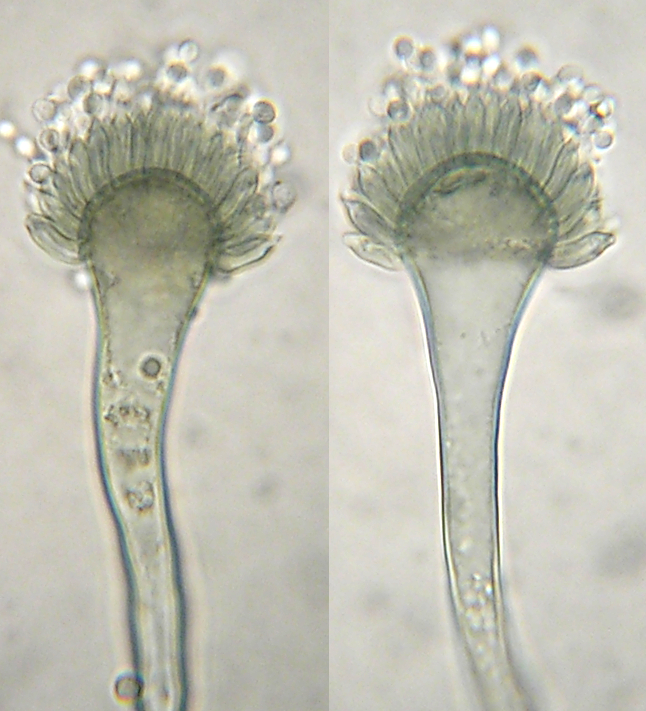
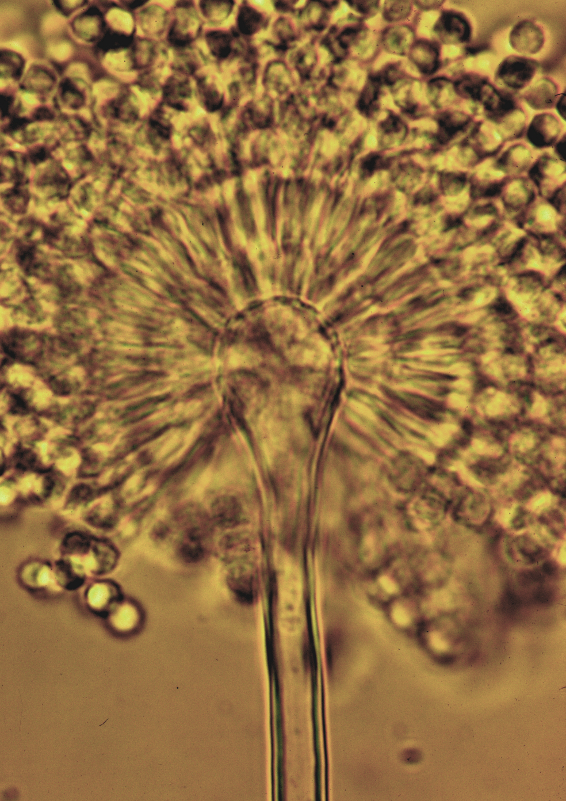
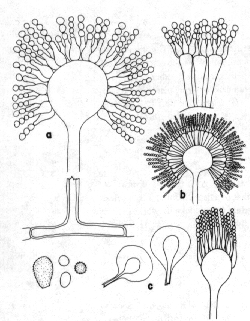
Recognized by its distinct conidiophores arising from a well-defined "foot cell" and terminated by a swollen vesicle bearing flask-shaped phialides. The phialides may be borne directly on the vesicle (a) or on intervening metulae (b). Some species may form masses of thick-walled cells called "hülle cells" (c). The spores come in several colours, depending upon the species, and are produced in long chains from the ends of the phialides.
Many species of Aspergillus are known to reproduce sexually, producing asci and ascospores. The asci are nearly spherical and are borne in nearly spherical cleistothecia. The cleistothecia may themselves be borne within stromatic tissues that range from simple masses of hülle cells to hard sclerotium-like structures. These are discussed in more detail in the section dealing with the Eurotiales. A number of genera have been proposed to accommodate these diverse teleomorphs, including Dichlaena, Emericella, Eurotium, Fennellia, Hemicarpenteles, Neopetromyces, Neosartorya, Petromyces, and Warcupiella. Genetic studies have shown these genera to be rather closely related and possibly not distinct from Aspergillus. At the very least, the genus Eurotium must be considered a later name for Aspergillus and therefore not "legally" acceptable.
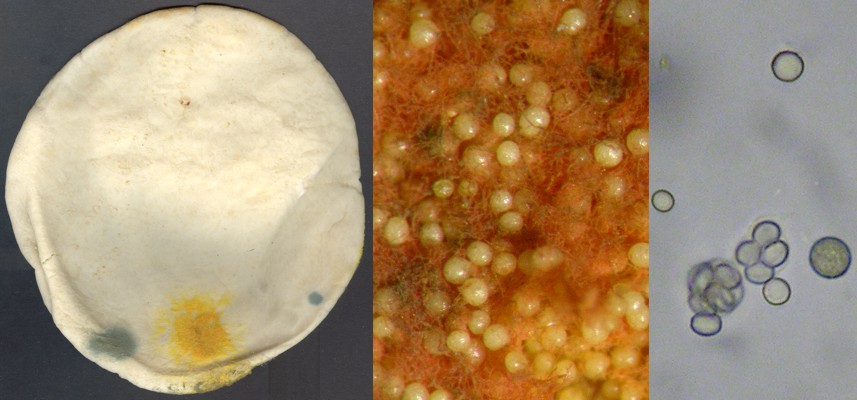
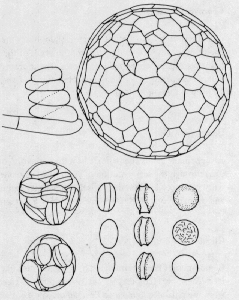
The three photographs above are of a strain of A. ruber found growing on an old pita bread in a New Brunswick home. The bright yellow-orange colony is typical of this group of Aspergillus species where the bright yellow cleistothecia greatly outnumber the green masses of conidia. The green colony at left is a species of Penicillium, probably P. chrysogenum. The middle panel is an enlargement of the colony showing the yellow cleistothecia nestled among the red hyphae characteristic of A. ruber. The right panel shows a group of spores. The darker, roughened spore at the right side of the picture and the two above are conidia; the rest are ascospores, which are shaped like minute hamburgers. In common with hamburgers, ascospores of Aspergillus species tend to come to rest on a top or bottom rather than on a side. Thus most of the ascospores look circular. However, two of these are lying on their side and thus have the elliptical outline of a hamburger as viewed by someone about to bite into it. The group of ascospores that are slightly out of focus are still inside an ascus, although the ascal wall cannot be seen. All of these features can be seen more clearly in the drawing at right. The coiled structure in the drawing is an ascogonial coil, discussed in greater in the discussion of the Sordariomycetes.
Aspergillus has had a long mycological history and in many way exemplifies the history of mycology itself. Because many of its species live in close association with humans it has been known by this name since Pier Antonio Micheli coined it in 1729, although it undoubtedly had vernacular names before that. Its reputation is mixed: on the one hand species of Aspergillus have long been used in the manufacture of citric acid, soy sauce and other useful products, while at the same time other species are known to produce highly toxic and carcinogenic substances in the foodstuffs they infest. Stored grains and other agricultural products are particularly vulnerable to these insidious moulds, requiring great vigilence on the part of agricultural authorities. For more information on these toxic moulds read the section on food in the chapter dealing with where fungi grow. The leftmost picture at the top of this page shows the conidial heads of Aspergillus fumigatus, a species causing disease in humans, especially those with compromised immune systems. This species has a tolerance for higher-than-usual incubation temperatures, allowing it to become especially abundant in bird's nexts.
Commonly isolated from soil, plant debris, and house dust; sometimes pathogenic to humans and other animals.
Classification: Trichocomaceae (Eurotiales). Refs: Klich, 2002; Klich and Pitt, 1988; Raper and Fennell 1965; Samson 1979; Samson and Varga, 2007; Samson et al., 2011; Seifert, 2000. Samson et al (2004) have a excellent presentation with a key, illustrations, discussions and descriptions of the species commonly found on foods and indoor environments. This will work very well for most species of Aspergillus found in indoor environments, but will be less useful for outdoor habitats, especially in the tropics.